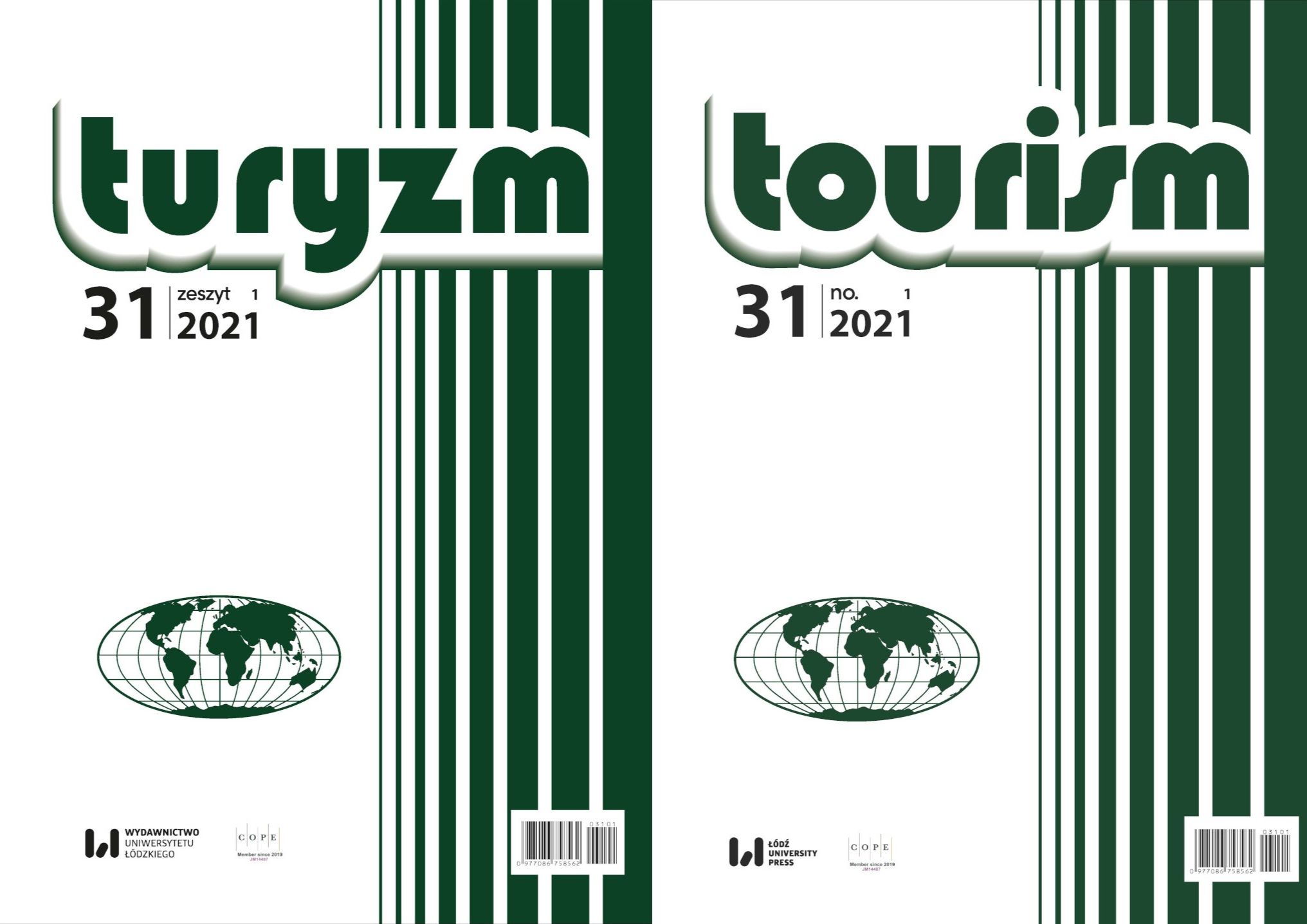Możliwości wykorzystania aplikacji opartych na grywalizacji i lokalizacji do promowania Sofii jako destynacji turystycznej
DOI:
https://doi.org/10.18778/0867-5856.31.1.03Keywords:
grywalizacja, aplikacja, turystyka, destynacja, SofiaAbstract
Głównym celem artykułu jest określenie możliwości wykorzystania aplikacji opartych na grywalizacji i lokalizacji w miejscowościach turystycznych. Celem szczegółowym jest zbadanie i ewaluacja już istniejących aplikacji tego typu dla Sofii, jak również odkrycie ich potencjału jako narzędzia marketingowego w rozwoju tego miasta turystycznego. Studium opiera się na przeglądzie literatury przedmiotu oraz badaniach kameralnych nad rolą, jaką w promocji Sofii jako destynacji turystycznej odgrywają dostępne aplikacje oparte na grywalizacji i lokalizacji. W ten sposób możliwe było przeprowadzenie analizy porównawczej głównych atrybutów aplikacji, które mają być stworzone w przyszłości. Zastosowano również technikę badań jakościowych, opierając się na wypowiedziach kluczowych informatorów, którzy stanowili eksperckie źródło informacji oraz umożliwili dokładniejsze przyjrzenie się bieżącym i potencjalnym praktykom w tym obszarze badawczym oraz ich skuteczności. Wyniki wskazują, że aplikacje oparte na zasadach gry komputerowej mają ogromne znaczenie dla postępującego zaangażowania użytkowników oraz współtworzenia produktów i usług, jak również dla zwiększania świadomości istnienia tej destynacji. Główne ograniczenia wynikają z faktu, że takie aplikacje są stosunkowo nowym i mało znanym narzędziem marketingowym w dziedzinie turystyki, a brak wystarczającej wiedzy i doświadczenia w ich użytkowaniu powoduje, że nie mogą być wykorzystywane w celach promocyjnych.
Downloads
References
About Questo (2021). Pobrane z: https://questoapp.com/about (24.01.2021).
Google Scholar
Chapman, A., Light, D. (2016). Exploring the tourist destination as a mosaic: The alternative lifecycles of the seaside amusement arcade sector in Britain. Tourism Management, 52, 254–263. https://doi.org/10.1016/j.tourman.2015.06.020
Google Scholar
DOI: https://doi.org/10.1016/j.tourman.2015.06.020
Correa, C., Kitano, C. (2015). Gamification in tourism: Analysis of Brazil Quest Game. e-Review of Tourism Research, 6, 1–5.
Google Scholar
Deci, E.L., Ryan, R.M. (1985). Cognitive evaluation theory. W: E.L. Deci , R.M. Ryan, Intrinsic motivation and self-determination in human behavior. Perspectives in social psychology (s. 43–85). Boston: Springer. https://doi.org/10.1007/978-1-4899-2271-7_3
Google Scholar
DOI: https://doi.org/10.1007/978-1-4899-2271-7_3
Deterding, S., Dixon, D., Khaled, R., Nacke, L. (2011). From game design elements to gamefulness: Defining “gamification”. W: MindTrek '11: Proceedings of the 15th international academic MindTrek conference: Envisioning future media environments (s. 9–15), September 2011. https://doi.org/10.1145/2181037.2181040
Google Scholar
DOI: https://doi.org/10.1145/2181037.2181040
Discover Sofia (2021). Pobrane z: https://www.secretcitytrails.com/product-category/discover-sofia/ (12.01.2021).
Google Scholar
Groh, F. (2012). Gamification: State of the art definition and utilization. W: Proceedings of the 4th seminar on research trends in media informatics (s. 39–46). 14 lutego 2012.
Google Scholar
Hofacker, C.F., De Ruyter, K., Lurie, N.H., Manchanda, P., Donaldson, J. (2016). Gamification and mobile marketing effectiveness. Journal of Interactive Marketing, 34, 25–36. https://doi.org/10.1016/j.intmar.2016.03.001
Google Scholar
DOI: https://doi.org/10.1016/j.intmar.2016.03.001
Maan, J. (2013). Social business transformation through gamification. International Journal of Managing Information Technology, 5 (3), 9–16. https://doi.org/10.5121/ijmit.2013.5302
Google Scholar
DOI: https://doi.org/10.5121/ijmit.2013.5302
Marinov, V. (2005). Partners for development. Partnership model for strategic planning of local development. Sofia: ECIP.
Google Scholar
Marinov, V. (2012). Key informants’ analysis of small scale tourism development in mountain villages. W: SEEmore conference: Mountain resources and their response to global change (abstracts) (s. 27–28). Ankara University, Turkey.
Google Scholar
Marinov, V., Dogramadjieva, E., Assenova, M., Petkova, E., Baikov, B. (2015). Tourism product development and marketing of Sofia metropolitan area: Business perceptions and priorities. W: I. Tózsa, A. Zátori (red.), Metropolitan tourism experience development (s. 51–67). Budapeszt: Corvinus University of Budapest.
Google Scholar
Marshal, M.N. (1996). The key informant technique. Family Practice, 13 (1), 92–97. https://doi.org/10.1093/fampra/13.1.92
Google Scholar
DOI: https://doi.org/10.1093/fampra/13.1.92
Negruşa, A.L., Toader, V., Sofică, A., Tutunea, M.F., Rus, R.V. (2015). Exploring gamification techniques and apps for sustainable tourism. Sustainability, 7 (8), 11160–11189. https://doi.org/10.3390/su70811160
Google Scholar
DOI: https://doi.org/10.3390/su70811160
Neuhofer, B., Buhalis, D., Ladkin, A. (2012). Conceptualising technology enhanced destination experiences. Journal of Destination Marketing & Management, 1 (1–2) , 36–46. https://doi.org/10.1016/j.jdmm.2012.08.001
Google Scholar
DOI: https://doi.org/10.1016/j.jdmm.2012.08.001
Nexto (2021). Pobrane z: https://nexto.io/ (13.01.2021).
Google Scholar
Schell, J. (2008). The art of game design: A book of lenses. Pittsburgh: CRC Press.
Google Scholar
DOI: https://doi.org/10.1201/9780080919171
Seaborn, K., Fels, D.I. (2015). Gamification in theory and action: A survey. International Journal of Human-Computer Studies, 74, 14–31. https://doi.org/10.1016/j.ijhcs.2014.09.006
Google Scholar
DOI: https://doi.org/10.1016/j.ijhcs.2014.09.006
Secretcitytrails (2021). Pobrane z: https://www.secretcitytrails.com/ (12.01.2021).
Google Scholar
Serdica Riddles (2021). Pobrane z: https://www.facebook.com/SerdicaRiddles/ (21.01.2021).
Google Scholar
Sever, N., Sever, G., Kuhzady, S. (2015). The evaluation of potentials of gamification in tourism marketing communication. International Journal of Academic Research in Business and Social Sciences, 5 (10), 188–202. https://doi.org/10.6007/IJARBSS/v5-i10/1867
Google Scholar
DOI: https://doi.org/10.6007/IJARBSS/v5-i10/1867
Swacha, J., Ittermann, R. (2017). Enhancing the tourist attraction visiting process with gamification: Key concepts. Engineering Management in Production and Service, 9 (4), 59–66. https://doi.org/10.1515/emj-2017-0031
Google Scholar
DOI: https://doi.org/10.1515/emj-2017-0031
Weber, J. (2014). Gaming and gamification in Tourism: 10 ways to make tourism more playful. Pobrane z: https://www.thinkdigital.travel/ (1.03.2021)
Google Scholar
Wu, L., Stilwell, M.A. (2018). Exploring the marketing potential of location-based mobile games. Journal of Research in Interactive Marketing, 12 (1), 22–44. https://doi.org/10.1108/JRIM-06-2017-0041
Google Scholar
DOI: https://doi.org/10.1108/JRIM-06-2017-0041
Xu, F., Buhalis, D., Weber, J. (2017). Serious games and gamification of tourism. Tourism Management, 60, 244–256. https://doi.org/10.1016/j.tourman.2016.11.020
Google Scholar
DOI: https://doi.org/10.1016/j.tourman.2016.11.020
Xu, F., Tian, F., Buhalis, D., Weber, J., Zhang, H. (2016). Tourists as mobile gamers: Gamification for tourism marketing. Journal of Travel and Tourism Marketing, 33 (8), 1124–1142. https://doi.org/10.1080/10548408.2015.1093999
Google Scholar
DOI: https://doi.org/10.1080/10548408.2015.1093999
Xu, F., Weber, J., Buhalis, D. (2014). Gamification in tourism. W: Z. Xiang, I. Tussyadiah (red.), Information and communication technologies in tourism (s. 525–537). Cham: Springer. https://doi.org/10.1007/978-3-319-03973-2
Google Scholar
DOI: https://doi.org/10.1007/978-3-319-03973-2_38
Xu, Y. (2012). Literature review on web app gamification and analytics. Honolulu: University of Hawaii. Pobrane z: https://citeseerx.ist.psu.edu/viewdoc/download?doi=10.1.1.462.5228&rep=rep1&type=pdf (1.03.2021)
Google Scholar
Yang, Y., Asaad, Y., Dwivedi, Y. (2017). Examining the impact of gamification on intention of engagement and brand attitude in the marketing context. Computers in Human Behavior, 73, 459–469. https://doi.org/10.1016/j.chb.2017.03.066
Google Scholar
DOI: https://doi.org/10.1016/j.chb.2017.03.066
Zichermann, G., Cunningham, C. (2011). Gamification by design: Implementing game mechanics in web and mobile apps. Sebastopol: O’Reilly Media Incorporated.
Google Scholar
Downloads
Published
How to Cite
Issue
Section
License

This work is licensed under a Creative Commons Attribution-NonCommercial-NoDerivatives 4.0 International License.










